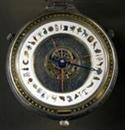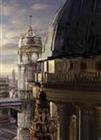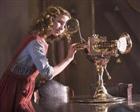The Movie
Cast | Director & Crew | Production Design | Auditions | Image Galleries | DiscussionWe have here a full transcript collection of what the various production designers working on The Golden Compass movie had to say at the set visit BridgeToTheStars.net made last month. Dribs and drabs have appeared elsewhere on the internet, but this is the only place you'll find what the three designers had to say in full. Here then is the design ethos of the film, in their own words (don't forget to click the images for larger versions):
Dennis Gassner - Production Design

Symbols
"The question that I had for everybody was: 'what is The Golden Compass?' And to me: I deal in symbols, I'm the architect of the film. How do you get into a world like this - which is a very unusual world - one that I haven't seen and nobody has? You start with just this: something simple. The simplicity for me was actually the sphere, which became the golden compass. The protagonist and the antagonist of our films - you need symbols - simply become that, symbols. The symbol for purity, for Lyra, and then the antithesis of that would be for me the oval, which is the extension or manifestation of that symbol. It's nice to have a contrast and you can start to build the world from there. That's how I started: very simply and very direct."
"I started with, obviously, Oxford. Much of the parallel world of Oxford exists here, but Jordan College doesn't. What does that look like? There was a word that I came up with on a film called Waterworld which was again the same futuristic type of world, an alternate world - and that word is called cludging. It's taking one element that exists and another element that exists and putting them together, combining into something else."
London
"London was particularly fun to do because you don't get to redesign London very often! I wanted to do that in an homage to Christopher Wren, who redesigned London [after the Great Fire] but never got to realise it - except for St. Paul's and some churches. I've kind of taken the symbol of St. Paul's as the keystone, and developed around that a more glass world."
"Choosing which existing London buildings to take out and which to leave was very, very complicated. The time period was obviously something that came forward actually quite quickly to me; sort of, 'where are we placing this?' This told me that story. I said, 'this will be the turn of the century to the 1940s. We have that window of 40 years for say.. for costume, for props; everybody needed to have a window in time to deal with. But it's a broad window of time. We're dealing with a generality and that opened things up - it's much more fun for the audience to look at because it is a fantasy even though we're basing it in a reality environment. We're saying, 'this is a real time, real place that you're in now.' But it gave me the scope to play with a lot of elements of time. And that accumulation is the exciting part about getting to do something like this."
Emotion
"With the production design as a whole, I choose what looks good. For me, it's the emotional content of the pieces. I react emotionally to material and say, 'oh, that feels about the right size and the right shape and the right proportion, because emotionally that should be happening at this point in the script.' The environment is really just the backdrop. Like any piece of architecture, any environment that we all go through, it's how it feels in space. A film envelopes you into an environment in which the story works and the characters in the story then manifest themselves as they do from the novel. That's why we're all doing this: because everybody enjoyed the book and we have to start somewhere, so we start with a good piece of material."
Snow
"How will the snowy setting of The Golden Compass differentiate itself from other fantasy films? Obviously color is really important, but also the architecture of the snow is also interesting. I've taken basically one crystal of snow and manifested it into a very large element. It's a fusion. I wanted a place where a meeting took place so the nature of snow and ice converge and create a massive shard, which gave a focal point to that world itself."
More symbols
"I remember when I first met Philip Pullman. He reinforced exactly the thing that I talked about with Deborah Forte. I said to him, 'What is The Golden Compass?' We went out to Oxford and we walked through some of the areas that he had imagined these scenes taking place in, because that's exactly what he had done by himself. He had wandered and thought of all these ideas. He took us to a small museum of timepieces and we went in. He would show me objects and say, 'well, this is an interesting piece and this is an interesting piece.' And I said, 'yes, but here's something that's actually more interesting to me.' I looked up and on the shelf there was a concave mirror. It was encased in a beautiful piece of wood and I looked at it and I said, 'Philip, to me that's the most interesting thing in this room because I can see both of us in that.' He was kind of standing away from me. What it did, it brought both of us together. And I said, 'This is a really key element of the film for some reason."
CGI
“Everything here is practical, but with extensions in CGI. When you have a long, long journey in how to make this movie, there's push and pull in all films so you say: 'What can we build physically? What does CGI have to take over?' It's a practical element of dealing with the financials of the film. You divide it up, you have so much money and you say, 'Where is it going to go? What's the best use of it?' "
Ruth Myers - Costume Design
Lyra
"Lyra makes a complete journey and it was a question of where to start her and where to finish her."
Mrs Coulter
"I've been doing this a long time, so a lot of things came to mind very quickly. This is a world where women don't wear trousers. I wanted to essentially give you the sense of Mrs Coulter being the most glamorous woman in the world, but I didn't want it to be now glamour. I had to go back and decide what I thought the most beautiful looking women had been."
"There's a lot of talk in the book of fur and I was very interested with the idea of actually not using very much real fur. I like the idea that I could play with other furs and again create a fur that we didn't know. So you can only see bits of them here. You possibly see one of Mrs. Coulter's coats on the screen and things like that, but these sort of fur bits that we've really worked into come from yet again another world."
Serafina Pekkala
"This is Serafina, who is a sort of pure shade of night. She has got this image: she is sort of your dream of midnight - or my dream of midnight. Her group goes slightly in other direction; they're not quite as pure as she is. The rest of the witches are a similar colour, but less rich."
General fashion
"I strived for clothes somewhat between 1920s Edwardian, 1940s, all mixed in. That was the idea, so that every time I thought I was going towards a period, I pushed it another way so that you got a sense of 'what is this?' Again, I wanted to give the crowds a sense that you didn't quite know if it was now, not now, when, how, so that you start the film off not quite sure where you are. Very, very good fun. We've taken modern things and played with them. We made period things, we moved them around. It's a world of elegance: by the time you get to the next book they talk about this world - our world. Nobody wears jeans and in this film, there isn't one pair of jeans! Women don't wear trousers; so we're living in a world that I'd quite like to live in."
Production
"I had a much easier job obviously because what I came into was a world that had already been created, in two senses. First: in the books, it says very clearly in the beginning that it's this world, it's not this world - which is what I read before I talked to anyone. That gives you the most amazing sense of scope. And secondly, I came into [concept designer] Dennis Gassner’s world, which is amazing and which gave me all sorts of references to be able to work with."
"One of the great joys actually about this book has been that we have been given the luxury of being able to make stuff ourselves. One of the reasons that you rent in the film industry is because you neither have the time nor the facilities to make. My department has made something like 600 costumes: we've painted, we've manufactured, we've done all sorts of extraordinary things. One of the great things about working here in Shepperton is that we've had the space and we've been able to bring in skilled people to do all these jobs. This is an incredible luxury. I myself am enormously proud of the work that we've done and I'm completely overwhelmed by what we've been able to do."
"It's been because we've all worked together. I've not had to go somewhere else to see what they were doing. In many ways, it's also made it economically a very viable thing because we've all been here together doing it. So although in the beginning, a lot of us thought it was going to be very expensive, in the end I think it's been a very, very - for what has come out which is huge - it's been a very economical way of doing it. And really, it doesn't look like anything else you've ever seen. We've not had to go and hire stuff. We've been given free range of what we want."
Barry Gibbs - Props
"The first prop we were asked to make for the film was the spirit projector* and, back in March, James Enright and I started to discuss how we were going to make things. He was convincing me to put in the budget for a forge so we could make everything for real in brass. We knew that the detailing was going to be required so we set up a forge back in May and as soon as this concept was signed off, this was the first thing to be made."
*one of several movie re-namings, this refers to the slide viewer Lord Asriel uses in the Retiring Room at the beginning of The Golden Comass.
"We were asked to create something not only beautiful to look at, but also slightly functional - so Lord Asriel was able to come in and actually operate this machine. The amber lighting was also practical and operated from a remote; we were able to put in the projector beam once the photogram was placed into the spirit projector. In all, to produce this piece was somewhere like 15 weeks' work. We had to create everything from scratch. From the concept we created a model - then into molding, forging, polishing, fitting, etc. All of the photograms were made too; although there's no image as such because that's put in with CG."
"We created our own lighting, which is an issue we had very early discussions on. With the lighting technicians we created a moving, almost plasma-like lighting which causes numerous problems [with filming], but we ended up succeeding, I think! It's been a great journey because we had the luck to make everything. We don't have to worry about borrowing, renting, we make it. It makes it more unique. Obviously rentals would be much cheaper, but you wouldn’t get the look. This is so defined. We've had to follow that role because - again - it's our world, but with a twist. You could look at the 1920s, 1930s zeppelins and you'd see the style of the luxury and the finishes - we've got to try and take that one step further."
"I think the thing is the finish. We have to create a prop that works for the period of time that we need it. At the end of the day, it is a film prop. It has to last for the scene. A lot of the furnishings we've done will stand the test of time. Obviously, all the brass fittings will last the test of time, namely for another two movies! So they have to be made for it."





